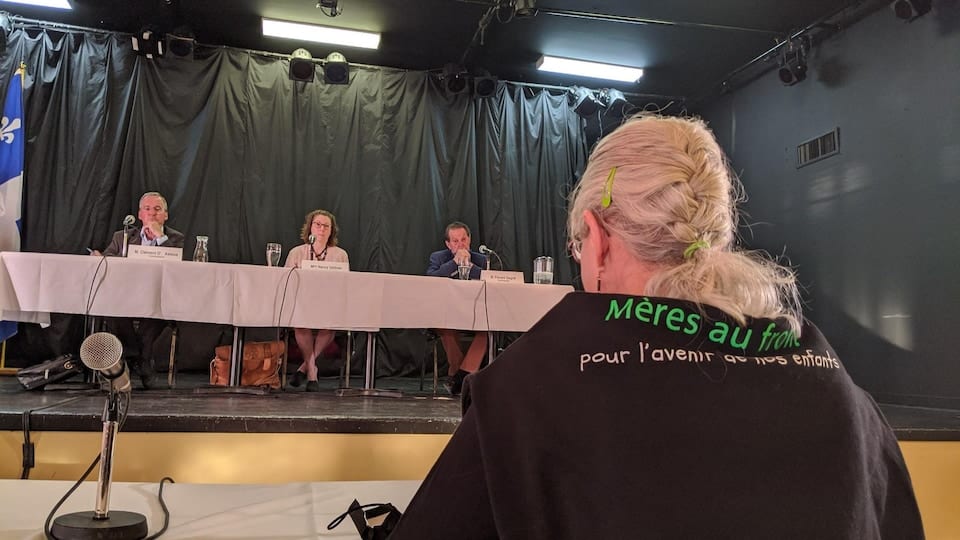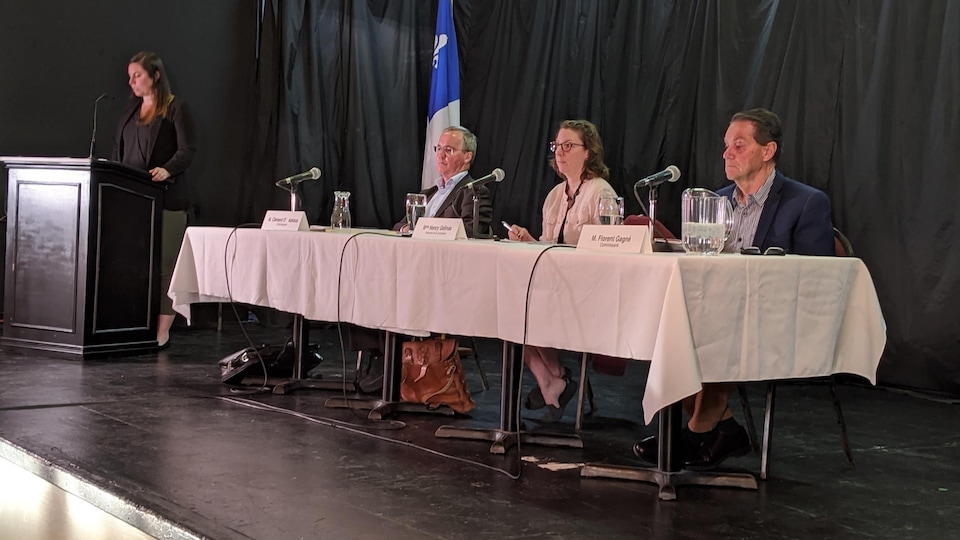About 70 people attend the meeting, which takes place in a community hall in the center of the Dam-en-Terre Resort.
The chair of the commission, Nancy Gélinas, first presented the mandate of the commission, which was created to contribute to the realization of a new version of the Caribou Habitat Protection Strategy, which been rejected twice by the CAQ government.
She also recalled the two hypothetical scenarios presented by the commission, while Saguenay-Lac-Saint-Jean would be the region most affected economically, according to one of the two scenarios presented by the commission. The scenarios were submitted by the Ministry of Forests, Wildlife and Parks (MFFP), which commissioned the commission.
- The first scenario proposes to increase the area under restoration of the caribou habitat zone. This scenario would impact forest industry activities in the region by removing 339,000 m3 of wood from the industry and result in the loss of 385 jobs.
- The second scenario proposes a reduction of the area under restoration of caribou habitat. It would have no impact on the forestry industry, but it would condemn 3 of the 12 caribou herds in Quebec, namely that of Pipmuacan, north of the Saguenay, as well as those of Charlevoix and Val-d’Or.
The caribou, the canary in the mine
Anne-Marie Chapleau, representative of the Saguenay group of the Mothers at the Front movement, was the first speaker to address the three commissioners during the period devoted to briefs. “The caribou is the canary in the mine,” she said, referring to the loss of biodiversity across the planet and the disappearance of species.
She called on political leaders to take brave decisions
and to listen to scientists and caribou decline specialists. “Are we morally entitled to not care for short-term benefits? “, she asked, answering in the negative.
Anne-Marie Chapleau’s intervention was then followed by a majority of political actors.
Concern over social and economic impacts
The prefect of the MRC of Maria-Chapdelaine, Luc Simard, for his part, reminded the commissioners of the significant dependence of the communities in his territory on the forest industry. While supporting the brief of Alliance forêt boréale, which proposes to extend the Woodland Caribou Recovery Plan in its current form beyond 2023, he called for continued experiments in land use planning, before making hasty decisions
.
“We have to take the time to experiment,” he pleaded, affirming the forest industry’s desire to innovate in its management and silvicultural practices. A hasty decision would have a significant impact on the industry and its workers. “When you think at the social and economic level, it risks dismantling our communities in a significant way,” he warned.
The prefect of the MRC from Domaine-du-Roy, Yanick Baillargeon, who is also president of Alliance forêt boréale, succeeded him at the microphone. He pleaded in favor of caribou protection, which would have no impact on the forestry industry and its workers. The two scenarios of the commission are not an option, in his eyes. “We cannot count on either scenario, given the lack of data we currently have,” he said.
A lack of information and precision recognized by the commission
The president of the commission then mentioned that the socio-economic impacts were a concern that came up several times during previous public hearings.
“There is indeed a lack of information on the socio-economic impacts,” she acknowledged, letting it be known that the commission would pass on this concern.
Gilles Bergeron, a retired economics professor from the University of Quebec at Chicoutimi (UQAC), for his part criticized the accuracy of the data in the sixty-page consultation document made available by the commission.
In particular, he questioned the number of jobs that would be affected in the region by the first scenario submitted, namely 385. “Where is this figure coming from? We don’t know,” he said.
A more specific impact on the other scenarios and the actions planned to protect the caribou, the impacts of the measures on the allowable cut, on the protected areas, on the socio-economic impacts according to the size of the companies and the environments, as well as on the measures of proposed economic diversification should be known, he said, criticizing the data provided in the document.
His speech was followed by a round of applause by several participants present.
The president of the commission, Nancy Gélinas, acknowledged the lack of information presented to the participants. “Regarding the figures, there is no more information, it is very simplistic as information”, she acknowledged, specifying that a broader impact study is expected.
The Pipmuacan herd
A second defense group, the Péribonka River Safeguarding Committee, presented at the end of the period devoted to the presentation of briefs its concerns regarding the preservation of the Pipmuacan herd.
The group’s spokesperson, Ève Tremblay, deplored that the second scenario submitted by the commission provides for a protective block east of the Pipmuacan reservoir, for the herd located north of the Saguenay, which includes several logging roads and resort, while the Péribonka River protection block has been abandoned.
She denounced the “complacency of the forest industry” with the MFFP, calling for the restoration of the Péribonka River protection block and its extension to include mature forests. The impact on the forest industry would allow correct past mistakes
. “It is only a fair return of things to return to a more respectful management of our forests, which has been lacking in the past”, she pleaded.
Tommy Tremblay, Director General of the Regional Council for the Environment and Sustainable Development (CREDD) in the region, also devoted his speech to the Pipmuacan herd, which “could precisely play a role in protection”. He said he understood the concerns of the forest industry and its workers. “Our families, our friends, live from the forest,” he said. Costs will be higher for communities, he said, if nothing is done, exposing possible market closures and environmental certification.
The second part of the public hearings is reserved for the public.
The last and seventh stop of the commission will be in Baie-Comeau next Tuesday. The commission’s recommendations are then expected at the end of the summer.
More details to come
Reference-ici.radio-canada.ca


